
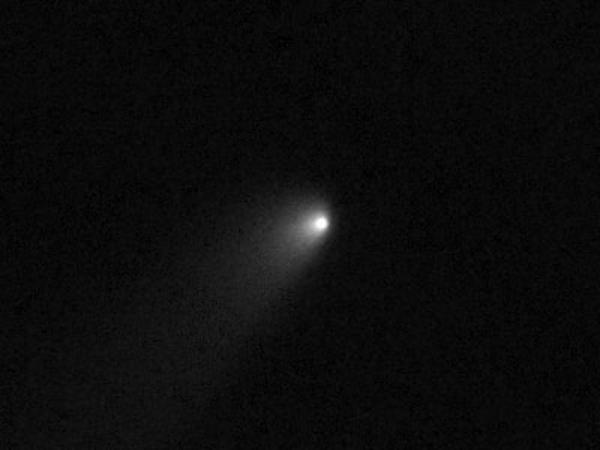
2019 LD2 as seen by the Hubble Space Telescope. The orbit of the small icy body is now changing, from traveling in the outer solar system between Jupiter and Neptune, to a closer region inside the orbit of Jupiter. Image via Hubble Space Telescope/ Bryce Bolin/ Planetary Science Institute.
There’s news about the comet labeled 2019 LD2 (ATLAS). Astronomers reported it in May of 2020 to be moving among giant planet Jupiter’s Trojan asteroids, a group of asteroids long known to have been captured by Jupiter’s strong gravity and to be moving in Jupiter’s orbit. It was a fun and surprising find: an object among the Trojan asteroids with a comet-like tail. But, not long afterwards, that result was retracted. Comet 2019 LD2’s orbit did not appear to make it a permanent member of the Trojan asteroid group; it was then seen as an interloper, only masquerading as a member of the Trojan population. But astronomers have continued to study this comet. In late November, they announced it as a great example of an orbit-hopping comet, moving from one orbit to another.
Long-period comets – those with orbits longer than 200 years – follow paths that regularly bring them closer to the sun, then carry them back to deep space again. But comets are tiny bodies, and they’re often pulled and pushed around by the gravity of the larger planets. Comets are known to move from one part of the solar system to another, as if wanting to check out a new neighborhood. Astronomers know all of this because they understand the physics of cometary orbits, and because they’ve observed many, many comets. The announcement in late November 2020 – by scientists at the Planetary Science Institute (PSI) – confirmed that Comet 2019 LD2 (ATLAS) is orbit-hopping, from the outer solar system to inside Jupiter’s orbit.
This discovery is the first of a new comet just before it began such a transition process.
The astronomers said this discovery will help them understand more on how comets evolve and “turn on” – get warming, and develop comas and comet tails – as they enter the inner solar system.
Their result was published on November 26, 2020, in a peer-reviewed paper in The Astrophysical Journal Letters.
2019 LD2 (ATLAS) is now classified as a Centaur object, which means that it travels around the sun on an orbit between Jupiter and Neptune. Centaur orbits tend to be unstable due to the gravity of the giant gas planets kicking them around. Sometimes as a result, a Centaur body can be pushed out of the solar system entirely, or its orbit can gradually move inward, closer to the sun than Jupiter.
Comets in that latter region are known as Jupiter-Family Comets, which means that they are influenced by the gravity of Jupiter and their trips around the sun take less than 20 years.
Comet 2019 LD2 appears to be a Centaur that will eventually be adopted into the Jupiter Family of Comets. It’s the first comet astronomers have caught in the process of making this orbital change.
See the illustrations below, of first of Centaurs (between Jupiter and Neptune) and then of Jupiter-Family Comets (closer to the sun than Jupiter).
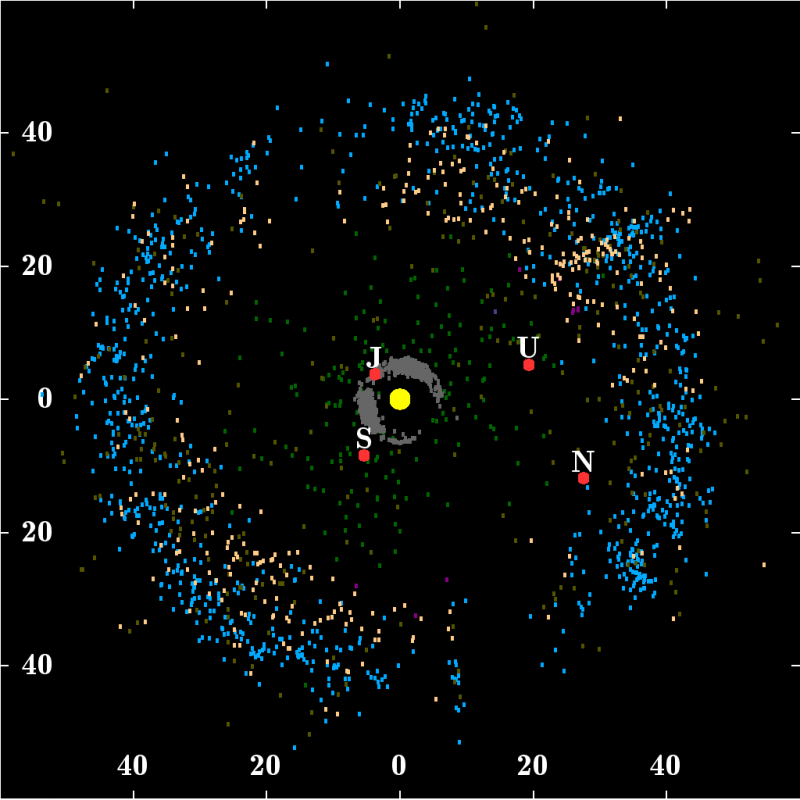
This image shows the positions of known outer solar system objects. The green dots here are Centaurs, located between the orbits of Jupiter and Neptune. Jupiter, Saturn, Uranus and Neptune are marked by J, S, U, and N and the sun is in the center. Image via WilyD/ Wikipedia/ CC BY-SA 3.0.
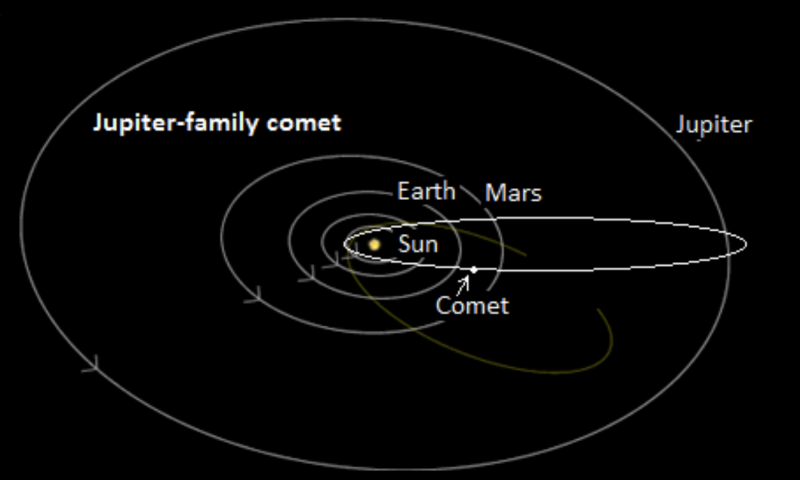
Jupiter-Family Comets orbit closer to the sun than Neptune. Their orbits are on the order of 20 years. Image via SimpleScience.
Jordan Steckloff, research scientist at PSI and lead author of the new study, said:
The newly discovered comet 2019 LD2 (ATLAS) is a Centaur, but is actively transitioning [to become one of the Jupiter Family of Comets]. It is in the very earliest parts of this transition, and is the first time an object has been discovered prior to embarking on this transition.
We find that 2019 LD2 is currently in the vicinity of [a region of space known as] a dynamical ‘gateway’ that facilitates the majority of transitions from the Centaur population into the Jupiter Family of Comets. The dynamical gateway is a region beyond Jupiter, extending to just inside of Saturn’s influence. Our previous work … found that the majority of Jupiter-Family Comets first pass through this dynamical gateway as Centaurs immediately prior to transitioning into the Jupiter-Family Comet population.
While Centaurs can migrate inward to become Jupiter-Family Comets, their journey actually began even farther out, beyond the orbit of Neptune. When in that part of the solar system, they are known as Trans-Neptunian Objects.
The journey is not quick, even though comets move at thousands of miles per hour. The entire trip from the region beyond Neptune to closer than Jupiter can take a few million years to tens of millions of years.

Jordan Steckloff at the Planetary Science Institute is lead author of the new study on comet 2019 LD2. Image via Planetary Science Institute.
Scientists think that 2019 LD2 is a pristine comet, meaning that it still retains its original water ice, since it has never been warm enough – close enough to the sun – for its ice to change states from ice directly into gas, a process called sublimation. Jordan Steckloff explained:
Although LD2 has likely lost some supervolatile (easy-to-vaporate) ices such as carbon dioxide ice (also known as dry ice) in the outer solar system beyond Jupiter, it is unlikely to have ever been in the inner solar system (where Earth, the other rocky planets, and Jupiter Family Comets orbit), which is warm enough for water ice to sublime (‘evaporate’ from solid to gas). This means that LD2 is a pristine comet, and presents a unique opportunity to observe how pristine Jupiter-Family Comets behave as their water ice begins to sublime for the first time and drive comet activity.
Moreover, this transition is likely to finish in only 40 years from now, which is a blink of an eye for astronomy.
This means that people alive today will be able to follow this object all the way through its transition into the Jupiter Family population.
Observing transitioning comets like 2019 LD2 – comets moving from one sort of orbit to another – will help scientists understand the differences between different kinds of comets and asteroids. This distinction has gotten blurry in recent decades, what with active comets, inactive comets, inactive asteroids, and so on. Some objects seem to belong to more than one category. For example, Centaurs and Main Belt comets sometimes look like asteroids, but then appear more like comets at other times.
It’s all an example that of the “net of language” that astronomers are attempting to throw over the natural space of our solar system. Language is precise, and the distinctions between some of these objects are minute.
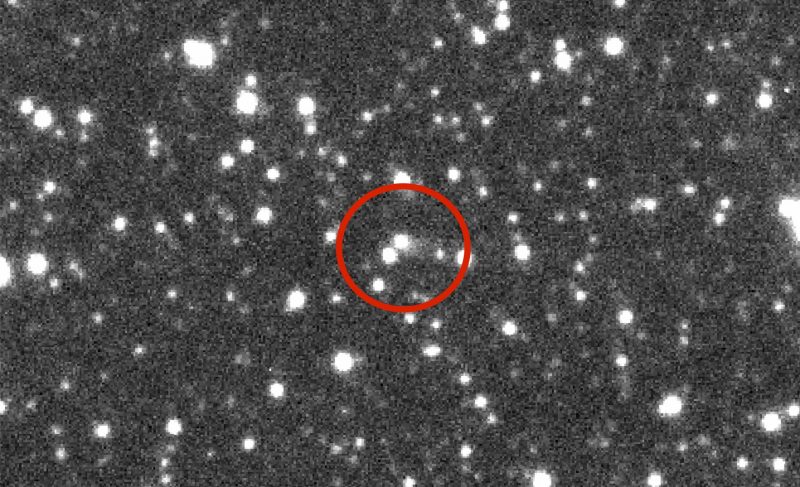
Another view of 2019 LD2, taken on June 11, 2019. See its faint tail, extending off to the right? Image via the Las Cumbres Observatory Global Telescope (LCOGT) network’s 1.0-meter telescope at Cerro Tololo, Chile/ J.D. Armstrong/ IfA.
Comet 2019 LD2 is a perfect example of an object that astronomers had a hard time categorizing. It appears to be a comet, but – earlier this year – astronomers were puzzling over why it might be part of Jupiter’s Trojan asteroid family, albeit with a comet-like tail. As reported by the University of Hawaii at the time:
Later, in July 2019, new ATLAS images caught 2019 LD2 again, now truly looking like a comet, with a faint tail made of dust or gas. The asteroid passed behind the sun and was not observable from the Earth in late 2019 and early 2020, but upon its reappearance in the night sky in April of 2020, routine ATLAS observations confirmed that it still looks like a comet. These observations showed that 2019 LD2 has probably been continuously active for almost a year.
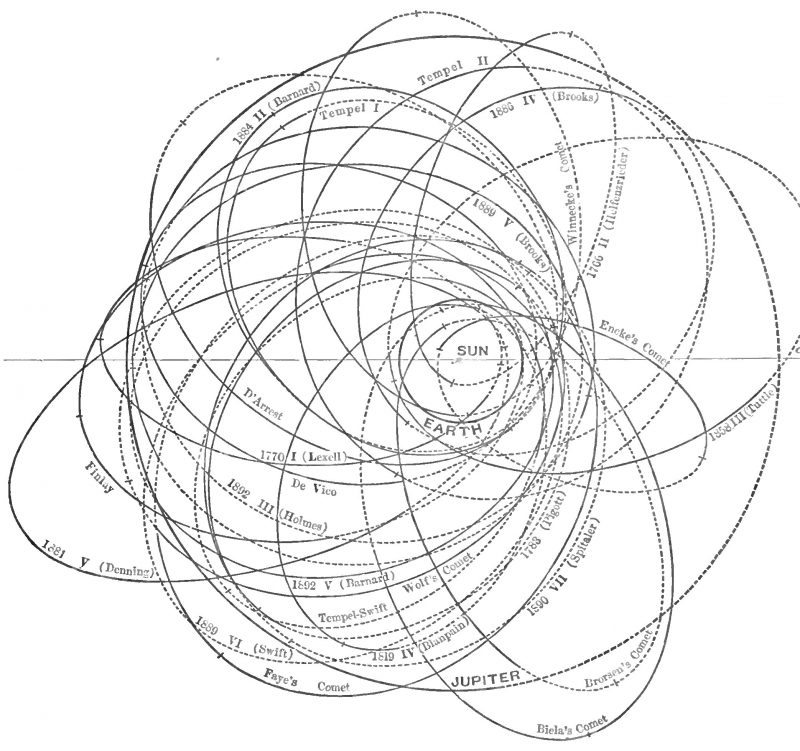
The Jupiter Family of Comets, as charted by Percival Lowell in 1903. Jupiter’s orbit is also depicted. These comets are short-period comets – orbital periods less than 20 years – and are influenced by the gravity of Jupiter. Comet 2019 LD2 is gradually transitioning in from the outer solar system to become a Jupiter-Family Comet. Image via Percival Lowell/ Wikisource/ Public Domain.
Bottom line: Comet 2019 LD2 was discovered in 2019. Last spring, scientists announced it was moving among Jupiter’s Trojan asteroids. Now they believe something different … that 2019 LD2 is in the process of changing its orbit from the outer solar system (between Jupiter and Neptune) to inside Jupiter’s orbit. It’s the first comet they’ve found said to be “transitioning” in this way.
Source: P/2019 LD2 (ATLAS): An Active Centaur in Imminent Transition to the Jupiter Family
Via Planetary Science Institute
from EarthSky https://ift.tt/3lPpu14


2019 LD2 as seen by the Hubble Space Telescope. The orbit of the small icy body is now changing, from traveling in the outer solar system between Jupiter and Neptune, to a closer region inside the orbit of Jupiter. Image via Hubble Space Telescope/ Bryce Bolin/ Planetary Science Institute.
There’s news about the comet labeled 2019 LD2 (ATLAS). Astronomers reported it in May of 2020 to be moving among giant planet Jupiter’s Trojan asteroids, a group of asteroids long known to have been captured by Jupiter’s strong gravity and to be moving in Jupiter’s orbit. It was a fun and surprising find: an object among the Trojan asteroids with a comet-like tail. But, not long afterwards, that result was retracted. Comet 2019 LD2’s orbit did not appear to make it a permanent member of the Trojan asteroid group; it was then seen as an interloper, only masquerading as a member of the Trojan population. But astronomers have continued to study this comet. In late November, they announced it as a great example of an orbit-hopping comet, moving from one orbit to another.
Long-period comets – those with orbits longer than 200 years – follow paths that regularly bring them closer to the sun, then carry them back to deep space again. But comets are tiny bodies, and they’re often pulled and pushed around by the gravity of the larger planets. Comets are known to move from one part of the solar system to another, as if wanting to check out a new neighborhood. Astronomers know all of this because they understand the physics of cometary orbits, and because they’ve observed many, many comets. The announcement in late November 2020 – by scientists at the Planetary Science Institute (PSI) – confirmed that Comet 2019 LD2 (ATLAS) is orbit-hopping, from the outer solar system to inside Jupiter’s orbit.
This discovery is the first of a new comet just before it began such a transition process.
The astronomers said this discovery will help them understand more on how comets evolve and “turn on” – get warming, and develop comas and comet tails – as they enter the inner solar system.
Their result was published on November 26, 2020, in a peer-reviewed paper in The Astrophysical Journal Letters.
2019 LD2 (ATLAS) is now classified as a Centaur object, which means that it travels around the sun on an orbit between Jupiter and Neptune. Centaur orbits tend to be unstable due to the gravity of the giant gas planets kicking them around. Sometimes as a result, a Centaur body can be pushed out of the solar system entirely, or its orbit can gradually move inward, closer to the sun than Jupiter.
Comets in that latter region are known as Jupiter-Family Comets, which means that they are influenced by the gravity of Jupiter and their trips around the sun take less than 20 years.
Comet 2019 LD2 appears to be a Centaur that will eventually be adopted into the Jupiter Family of Comets. It’s the first comet astronomers have caught in the process of making this orbital change.
See the illustrations below, of first of Centaurs (between Jupiter and Neptune) and then of Jupiter-Family Comets (closer to the sun than Jupiter).

This image shows the positions of known outer solar system objects. The green dots here are Centaurs, located between the orbits of Jupiter and Neptune. Jupiter, Saturn, Uranus and Neptune are marked by J, S, U, and N and the sun is in the center. Image via WilyD/ Wikipedia/ CC BY-SA 3.0.

Jupiter-Family Comets orbit closer to the sun than Neptune. Their orbits are on the order of 20 years. Image via SimpleScience.
Jordan Steckloff, research scientist at PSI and lead author of the new study, said:
The newly discovered comet 2019 LD2 (ATLAS) is a Centaur, but is actively transitioning [to become one of the Jupiter Family of Comets]. It is in the very earliest parts of this transition, and is the first time an object has been discovered prior to embarking on this transition.
We find that 2019 LD2 is currently in the vicinity of [a region of space known as] a dynamical ‘gateway’ that facilitates the majority of transitions from the Centaur population into the Jupiter Family of Comets. The dynamical gateway is a region beyond Jupiter, extending to just inside of Saturn’s influence. Our previous work … found that the majority of Jupiter-Family Comets first pass through this dynamical gateway as Centaurs immediately prior to transitioning into the Jupiter-Family Comet population.
While Centaurs can migrate inward to become Jupiter-Family Comets, their journey actually began even farther out, beyond the orbit of Neptune. When in that part of the solar system, they are known as Trans-Neptunian Objects.
The journey is not quick, even though comets move at thousands of miles per hour. The entire trip from the region beyond Neptune to closer than Jupiter can take a few million years to tens of millions of years.

Jordan Steckloff at the Planetary Science Institute is lead author of the new study on comet 2019 LD2. Image via Planetary Science Institute.
Scientists think that 2019 LD2 is a pristine comet, meaning that it still retains its original water ice, since it has never been warm enough – close enough to the sun – for its ice to change states from ice directly into gas, a process called sublimation. Jordan Steckloff explained:
Although LD2 has likely lost some supervolatile (easy-to-vaporate) ices such as carbon dioxide ice (also known as dry ice) in the outer solar system beyond Jupiter, it is unlikely to have ever been in the inner solar system (where Earth, the other rocky planets, and Jupiter Family Comets orbit), which is warm enough for water ice to sublime (‘evaporate’ from solid to gas). This means that LD2 is a pristine comet, and presents a unique opportunity to observe how pristine Jupiter-Family Comets behave as their water ice begins to sublime for the first time and drive comet activity.
Moreover, this transition is likely to finish in only 40 years from now, which is a blink of an eye for astronomy.
This means that people alive today will be able to follow this object all the way through its transition into the Jupiter Family population.
Observing transitioning comets like 2019 LD2 – comets moving from one sort of orbit to another – will help scientists understand the differences between different kinds of comets and asteroids. This distinction has gotten blurry in recent decades, what with active comets, inactive comets, inactive asteroids, and so on. Some objects seem to belong to more than one category. For example, Centaurs and Main Belt comets sometimes look like asteroids, but then appear more like comets at other times.
It’s all an example that of the “net of language” that astronomers are attempting to throw over the natural space of our solar system. Language is precise, and the distinctions between some of these objects are minute.

Another view of 2019 LD2, taken on June 11, 2019. See its faint tail, extending off to the right? Image via the Las Cumbres Observatory Global Telescope (LCOGT) network’s 1.0-meter telescope at Cerro Tololo, Chile/ J.D. Armstrong/ IfA.
Comet 2019 LD2 is a perfect example of an object that astronomers had a hard time categorizing. It appears to be a comet, but – earlier this year – astronomers were puzzling over why it might be part of Jupiter’s Trojan asteroid family, albeit with a comet-like tail. As reported by the University of Hawaii at the time:
Later, in July 2019, new ATLAS images caught 2019 LD2 again, now truly looking like a comet, with a faint tail made of dust or gas. The asteroid passed behind the sun and was not observable from the Earth in late 2019 and early 2020, but upon its reappearance in the night sky in April of 2020, routine ATLAS observations confirmed that it still looks like a comet. These observations showed that 2019 LD2 has probably been continuously active for almost a year.

The Jupiter Family of Comets, as charted by Percival Lowell in 1903. Jupiter’s orbit is also depicted. These comets are short-period comets – orbital periods less than 20 years – and are influenced by the gravity of Jupiter. Comet 2019 LD2 is gradually transitioning in from the outer solar system to become a Jupiter-Family Comet. Image via Percival Lowell/ Wikisource/ Public Domain.
Bottom line: Comet 2019 LD2 was discovered in 2019. Last spring, scientists announced it was moving among Jupiter’s Trojan asteroids. Now they believe something different … that 2019 LD2 is in the process of changing its orbit from the outer solar system (between Jupiter and Neptune) to inside Jupiter’s orbit. It’s the first comet they’ve found said to be “transitioning” in this way.
Source: P/2019 LD2 (ATLAS): An Active Centaur in Imminent Transition to the Jupiter Family
Via Planetary Science Institute
from EarthSky https://ift.tt/3lPpu14

Aucun commentaire:
Enregistrer un commentaire